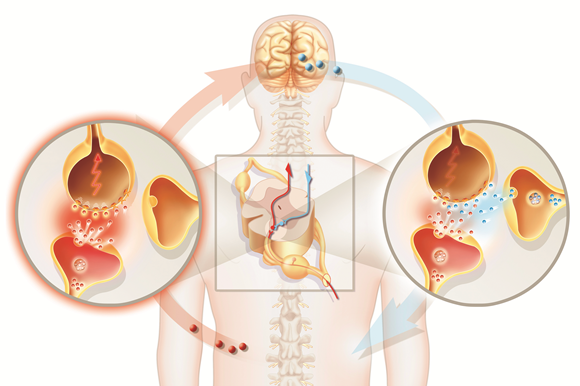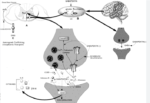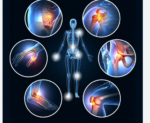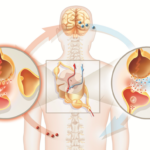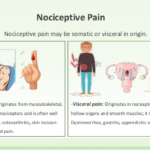Neuropathic pain is the result of an injury or problem with the nerves themselves. The pain is often triggered by an injury or an operation. Any event that can cause an injury to your body has the potential to damage the nerves at the same time.
For example, if a muscle is crushed, then the nerves within the muscle may also be crushed. Nerves can also be damaged or squeezed by tumours and scar tissue, or irritated by an infection.
Neuropathic pain often feels like burning, stabbing, or an electric shock. Strong pain from a light touch is also common. Neuropathic pain may last for months or years – long after the injury appears to have healed. Such pain means the problem is with the nervous system itself.
Examples: Failed Back Surgery Syndrome, Neuralgia, reflex sympathetic dystrophy (nerve damage), certain cancer pain, phantom limb pain, a trapped nerve, and peripheral neuropathy (widespread nerve damage).
There are many causes of peripheral neuropathy, diabetes being the most common. But it can also be caused by chronic alcohol abuse, exposure to toxins (unhealthy chemicals), lack of certain vitamins and a large variety of other problems. The cause is often never known.
What is Neuropathic Pain?
Neuropathic pain, often referred to as nerve pain, is a type of chronic pain that results from damage or dysfunction of the nervous system. It can be caused by various underlying conditions or injuries that affect the nerves, both in the central nervous system (CNS), which includes the brain and spinal cord, and the peripheral nervous system (PNS), which includes the nerves throughout the body.
Neuropathic pain can happen if your nervous system is damaged or not working correctly. You can feel pain from any of the various levels of the nervous system—the peripheral nerves, the spinal cord and the brain. Together, the spinal cord and the brain are known as the central nervous system. Peripheral nerves are the ones that are spread throughout the rest of your body to places likes organs, arms, legs, fingers and toes.
Damaged nerve fibers send the wrong signals to pain centers. Nerve function may change at the site of the nerve damage, as well as areas in the central nervous system (central sensitization).
Neuropathy is a disturbance of function or a change in one or several nerves. Diabetes is responsible for about 30% of neuropathy cases. It is not always easy to tell the source of the neuropathic pain. There are hundreds of diseases that are linked to this kind of pain.
Neuropathic pain is characterized by its unique qualities and is distinct from other forms of pain.
Key features of neuropathic pain include:
- Abnormal Sensations: Neuropathic pain is often described as shooting, burning, stabbing, tingling, electric shock-like, or pins-and-needles sensations. It can also be experienced as extreme sensitivity to touch (allodynia) or spontaneous pain without an apparent trigger.
- Chronic Nature: Neuropathic pain is typically long-lasting and can persist for months or even years. It may be episodic, with periods of flare-ups and remission.
- Nerve-Specific Location: The pain is often localized to a specific area served by the affected nerves. For example, diabetic neuropathy can lead to pain and numbness in the feet.
- Functional Impairment: Neuropathic pain can significantly impact a person’s quality of life, making it difficult to perform daily activities, sleep, or concentrate.
- Underlying Causes: Neuropathic pain can result from a variety of causes, including nerve injury, compression, inflammation, or disease. Common conditions associated with neuropathic pain include diabetic neuropathy, postherpetic neuralgia (shingles), trigeminal neuralgia, and carpal tunnel syndrome.
- Neurological Abnormalities: In many cases, diagnostic tests like nerve conduction studies, electromyography, or imaging may reveal structural or functional abnormalities in the nervous system that contribute to the pain.
- Limited Response to Traditional Pain Medications: Neuropathic pain often responds poorly to traditional pain relievers like nonsteroidal anti-inflammatory drugs (NSAIDs). Medications like antidepressants and anticonvulsants are often more effective in managing this type of pain.
It’s important to diagnose and manage neuropathic pain properly, as it can be complex and challenging to treat. Treatment strategies may involve medications, physical therapy, non-pharmacological interventions, and addressing the underlying cause if possible.
For More about Nerve Pain, please check: Neuropathic Pain
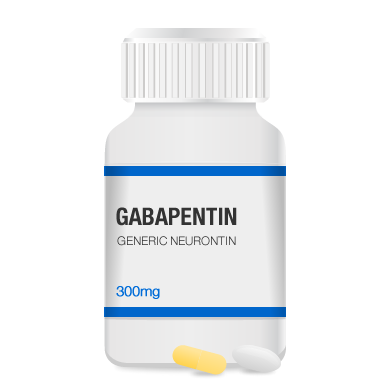
![]()
16 Million Americans Are Living With Chronic Neuropathic Pain
Utilizing clinical examination data from this study and assuming that pain prevalence rates are consistent across racial groups, our estimation suggests that nearly 16 million Americans are living with chronic neuropathic pain[1]. We concur with Morley-Forster’s observation that there appears to be an unmet demand for effective medical treatments for neuropathic pain.
Among those individuals with clinical evidence of neuropathic pain, a noteworthy 8.0% disclosed that they had not engaged in discussions about their pain with any medical professional. Furthermore, a substantial portion of those enduring chronic neuropathic pain have turned to alternative therapies, including acupuncture (more than 1 in 10), herbal remedies (approximately 1 in 5), and chiropractic care (approximately 1 in 2). This indicates that either traditional medical approaches alone have not provided a solution to their pain issue or that they have opted not to utilize the conventional treatments currently available.
It’s worth noting that the percentage of neuropathic pain sufferers turning to alternative forms of care surpasses the reported figures for acupuncture (less than 5%) and chiropractic care (7.4%) utilization among the entire U.S. adult population as of 2002. The proportion of chronic neuropathic pain patients using herbal supplements aligns with the usage rate for the general U.S. population (18.6%).
What Strategies Can Help With Nerve Pain?
Nerve pain, also known as neuropathic pain, can be challenging to manage, but there are several strategies and treatments that can help alleviate or reduce its severity. It’s important to note that the most effective approach may vary from person to person, and consulting a healthcare professional is crucial for proper diagnosis and treatment.
Here are more than 20 strategies for managing nerve pain in detail:
- Prescription Medications:
- Antidepressants: Tricyclic antidepressants (e.g., amitriptyline) and serotonin-norepinephrine reuptake inhibitors (e.g., duloxetine) can help manage nerve pain.
- Anticonvulsants: Medications like gabapentin and pregabalin are often used to alleviate neuropathic pain.
- Over-the-Counter Pain Relievers:
- Nonsteroidal anti-inflammatory drugs (NSAIDs) like ibuprofen or acetaminophen can offer mild pain relief for some individuals.
- Opioid Medications:
- Opioids are prescribed for severe nerve pain when other treatments are ineffective. They are typically used as a last resort due to the risk of addiction and side effects.
- Topical Treatments:
- Capsaicin Cream: Available over the counter, capsaicin cream can reduce pain by desensitizing nerves in the affected area.
- Lidocaine Patches or Creams: These products provide localized numbing effects, which can alleviate pain.
- Physical Therapy:
- A physical therapist can design an exercise program to improve strength, flexibility, and posture, which can help manage nerve pain.
- Nerve Blocks:
- Injections of local anesthetics or steroids can block pain signals in specific nerves, providing temporary relief.
- Transcutaneous Electrical Nerve Stimulation (TENS):
- TENS devices deliver low-level electrical impulses to the skin over the painful area, interfering with nerve signals and reducing pain.
- Acupuncture:
- Acupuncture involves inserting thin needles into specific points on the body, which some individuals find effective in managing nerve pain.
- Biofeedback:
- Biofeedback therapy can teach individuals to control bodily functions, including pain perception, through mental techniques and relaxation exercises.
- Lifestyle Modifications:
- Managing Underlying Conditions: Treating the root cause of nerve pain, such as diabetes, can significantly improve symptoms.
- Diet and Nutrition: Maintaining a healthy diet and managing blood sugar levels is particularly important for people with diabetic neuropathy.
- Stress Management: Stress can exacerbate nerve pain. Relaxation techniques like meditation and deep breathing exercises can be helpful.
- Alternative Therapies:
- Herbal Remedies and Supplements: Some people find relief from nerve pain using supplements like alpha-lipoic acid or herbs like St. John’s Wort, but consult a healthcare provider before using them.
- Medical Cannabis or CBD Products: These are used by some individuals for pain relief, but their efficacy can vary, and their legal status may vary by location.
- Support Groups and Counseling:
- Living with chronic pain can be emotionally challenging. Joining a support group or seeking counseling can help individuals cope with the emotional and psychological aspects of nerve pain.
- Nutritional Therapy:
- Proper nutrition can support nerve health. Ensure you get adequate B vitamins, especially B12 and folate, which are crucial for nerve function.
- Hydrotherapy:
- Soaking in warm water can relax muscles and relieve nerve pain. Hot or cold compresses applied to the affected area may also help.
- Massage Therapy:
- Therapeutic massage can reduce muscle tension, improve circulation, and alleviate nerve pain in some cases.
- Occupational Therapy:
- Occupational therapists can help individuals adapt to daily activities, making them more manageable despite nerve pain.
- Mental Health Counseling:
- Addressing anxiety, depression, and stress through counseling or therapy can indirectly improve the perception and management of nerve pain.
- Herbal Teas:
- Some herbal teas, such as chamomile and valerian root, have mild sedative effects that may help with pain management and sleep.
- Mind-Body Techniques:
- Practices like yoga, tai chi, and mindfulness meditation can promote relaxation, reduce stress, and improve overall well-being, which may help with nerve pain.
- Acupressure:
- Similar to acupuncture, acupressure stimulates specific points on the body, but it uses pressure instead of needles. Some individuals find it helpful for pain relief.
- Electromagnetic Field Therapy:
- Electromagnetic field therapy devices are designed to promote tissue healing and pain relief by stimulating electrical activity in cells. Consult a healthcare professional before using such devices.
- Intravenous Immunoglobulin (IVIg) Therapy:
- In certain autoimmune-related neuropathies, IVIg therapy may be considered to modulate the immune response and reduce nerve pain.
- Nerve Decompression Surgery:
- For certain compressive neuropathies, such as carpal tunnel syndrome, surgical procedures may be necessary to alleviate nerve pressure.
- Radiofrequency Ablation (RFA):
- RFA is a minimally invasive procedure that uses radiofrequency waves to disrupt nerve signals, providing relief from chronic pain.
- Spinal Cord Stimulation (SCS):
- SCS involves implanting a device that sends electrical signals to the spinal cord to interfere with pain signals, offering relief for some types of nerve pain.
Please remember that the effectiveness of these strategies can vary depending on the specific cause and individual circumstances of your nerve pain
What Are the Medications for Neuropathic Pain ?
Medications for neuropathic pain aim to manage the symptoms and provide relief by targeting the nervous system. The choice of medication can depend on the underlying cause of the neuropathic pain, individual factors, and the severity of the pain. Here are some common medications used to treat neuropathic pain:
- Antidepressants:
- Tricyclic Antidepressants (TCAs): Examples include amitriptyline, nortriptyline, and desipramine. These can help with neuropathic pain by altering the perception of pain and by increasing certain neurotransmitters in the brain.
- Serotonin-Norepinephrine Reuptake Inhibitors (SNRIs): Medications like duloxetine and venlafaxine can provide pain relief by affecting neurotransmitters involved in pain perception.
- Selective Serotonin Reuptake Inhibitors (SSRIs): Some SSRIs, such as paroxetine and citalopram, may also be used for neuropathic pain, although they are generally less effective than TCAs or SNRIs.
- Anticonvulsants:
- Gabapentin and Pregabalin: These medications are commonly used to treat neuropathic pain, particularly in conditions like diabetic neuropathy and postherpetic neuralgia. They work by modulating nerve signaling.
- Carbamazepine: Often used for trigeminal neuralgia and other neuropathic pain conditions, carbamazepine can reduce pain by stabilizing overactive nerves.
- Opioid Analgesics:
- Topical Medications:
- Lidocaine Patches or Creams: These provide localized numbing effects and can be applied directly to the painful area.
- Capsaicin Cream: Over-the-counter capsaicin creams can be applied to the skin to reduce pain by desensitizing nerve endings.
- NMDA Receptor Antagonists:
- Ketamine: In some cases, intravenous (IV) or oral ketamine may be used to manage severe neuropathic pain. It works by blocking NMDA receptors involved in pain signaling.
- Muscle Relaxants:
- Medications like baclofen or tizanidine may be prescribed to manage neuropathic pain associated with muscle spasms or spasticity.
- Steroids:
- In some cases, corticosteroids like prednisone may be prescribed to reduce inflammation and relieve pain, particularly when inflammation is contributing to neuropathic pain.
- Narcotic Analgesics:
- In rare cases, powerful narcotic pain medications may be used for severe neuropathic pain, although they are generally avoided due to their potential for addiction and side effects.
- Nerve Block Injections:
- Local anesthetics and corticosteroids can be injected into specific nerves to block pain signals.
- Neurostimulation:
- Devices like spinal cord stimulators or peripheral nerve stimulators can be implanted to provide electrical impulses that interfere with pain signals.
- Botox Injections:
- Botulinum toxin injections can be used to relieve pain in certain neuropathic pain conditions, such as trigeminal neuralgia.
It’s essential to consult a healthcare professional to determine the most appropriate medication and treatment plan for your specific neuropathic pain condition.
Is Gabapentin the Most Used Medications for Nerve Pain ?
Gabapentin is one of the commonly used medications for nerve pain, but whether it is the “most used” medication for nerve pain may vary depending on the specific condition, the individual patient, and their healthcare provider’s preferences. Gabapentin, along with its closely related medication pregabalin, is often prescribed to manage neuropathic pain. These medications are effective in reducing certain types of nerve pain, such as diabetic neuropathy, postherpetic neuralgia (pain after shingles), and neuropathic pain associated with conditions like fibromyalgia.
The choice of medication for nerve pain depends on various factors, including the underlying cause of the pain, the patient’s medical history, potential side effects, and individual responses to the medication. Some patients may respond well to gabapentin, while others may find relief with other medications or a combination of treatments.
[1] https://www.ncbi.nlm.nih.gov/pmc/articles/PMC2964880/
Pain Medications, Pain Relief, and Pain Management
